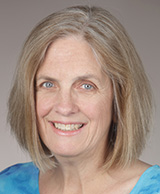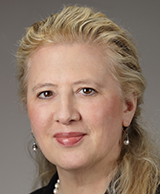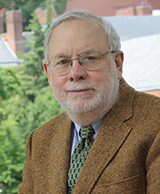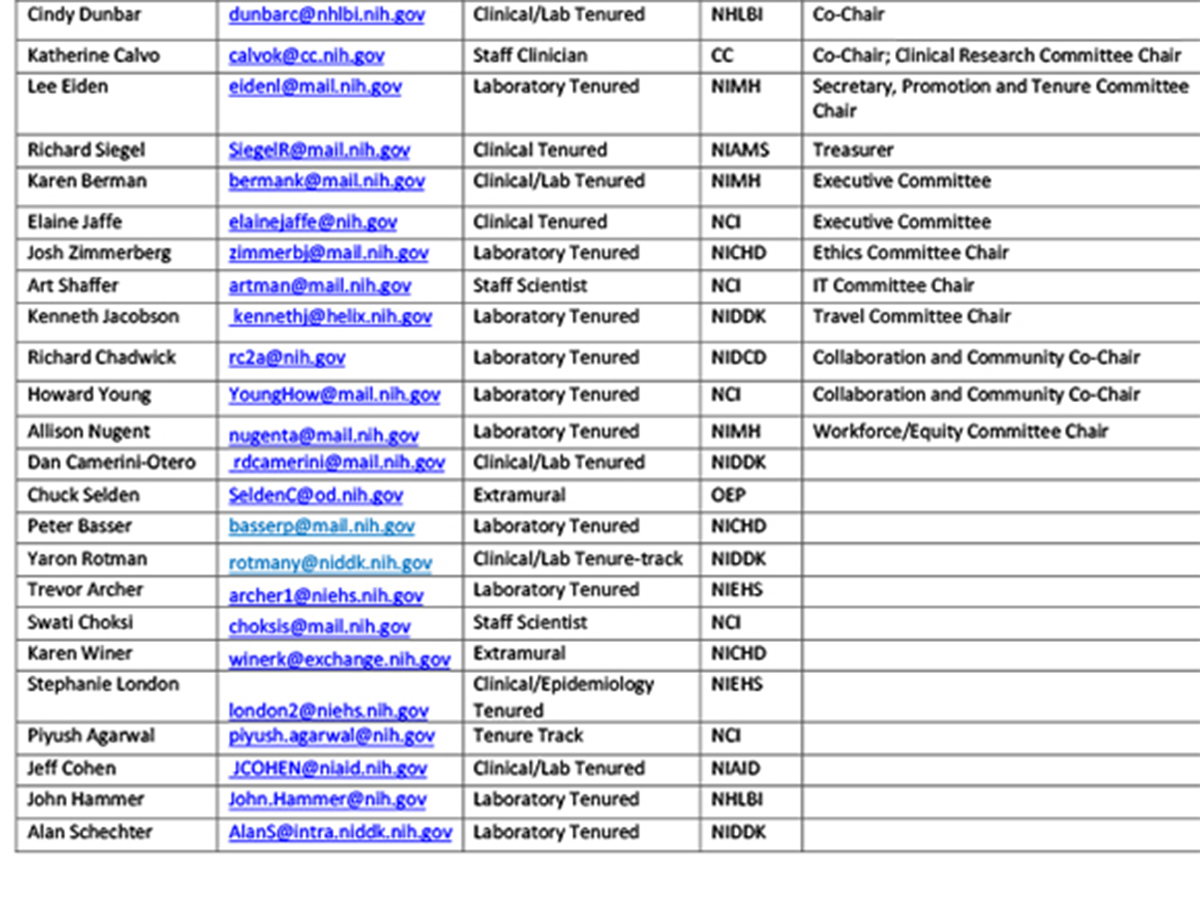Guest Editorial
The NIH Assembly of Scientists
What We Do and How It Affects You

PHOTO BY ERNIE BRANSON
Cynthia Dunbar

PHOTO BY ERNIE BRANSON
Katherine Calvo
We appreciate this opportunity to update the NIH community on the Assembly of Scientists’ (AOS) current activities and future priorities. As recounted in Alan Schechter’s history of the AOS (see “A Brief History” below), robust engagement among the NIH scientific community, NIH leadership, and the AOS has waxed and waned around specific events and issues that have influenced scientific productivity and quality of life at the NIH. In 2016, the AOS amplified its role by becoming an advisory body to the Deputy Director for Intramural Research (DDIR).
The AOS’s objectives, as codified in its bylaws, include 1) the advancement of science and the maintenance of the highest standards of scientific research; 2) the maintenance of the highest standards in the translation of scientific discoveries to the care of patients suffering from disease; and 3) providing a forum and a representative voice for AOS members on issues that are critical to their accomplishment of the first two objectives.
Membership in AOS is automatic (unless declined) for all intramural tenured and tenure-track investigators, staff clinicians or scientists, senior scientists or clinicians, assistant clinical investigators, and senior extramural program staff members. The AOS is similar to a faculty senate at an academic institution. The members elect a council consisting of 24 representatives, each serving four-year terms with half the seats up for election every two years. To provide input from individuals with a diversity of roles and experiences at the NIH, council membership consists of representatives from at least 12 different institutes or centers and includes at least one tenure-track investigator, staff clinician, and staff scientist. The council organizes standing and ad hoc committees that address specific areas: clinical research, ethics, information technologies, collaboration and community (includes issues of building communities within the intramural program and with extramural entities), promotion and tenure, travel, and workforce (includes equity and diversity).
The council meets monthly, but much of AOS’s work is done by the committees. For example, the AOS Clinical Research Committee has coordinated with NIH’s Staff Clinician Committee and NIH leadership to help design and implement due-process procedures for clinical investigators who have allegedly committed clinical-research regulatory violations; and to improve career-advancement pathways for staff clinicians. Both topics have resulted in spirited discourse. Concrete steps are being taken to address these issues with the intent of enhancing the retention and recruitment of outstanding clinicians at the NIH.
Representatives from the AOS council are also ad hoc members of—and attend meetings of—critical NIH bodies such as the Board of Scientific Directors, the Clinical Directors Committee, the Medical Executive Committee, the new NIH Equity Committee, and the Deputy Ethics Councilors Committee. With AOS having a seat at the table, information flows between AOS members and these policy and implementation groups, allowing NIH senior leaders to gain perspective on NIH scientists’ and clinicians’ concerns. We believe that these continued interactions allow us to work toward improving the overall environment for science on campus.
The AOS yearly “town hall” meeting—held each spring—provides an additional forum for the AOS council and invited NIH leaders to interact with AOS members. Everyone is welcome to attend these meetings (but only members can vote). The meetings are announced via e-mail from DDIR Michael Gottesman.
Council priorities are informed by the AOS survey, which is circulated every two years. Nearly 800 individuals—approximately 30 percent of the over 2,500 AOS members—completed the fall 2017 survey. (We thank you for participating!) This survey gave the AOS council a comprehensive snapshot of our members’ priorities for the future. We have provided relevant portions of the survey data to NIH leadership to highlight critical issues and stimulate them to work with us to try to solve ongoing problems.
Some of the most pressing concerns raised more frequently than on prior surveys included departures of active clinicians from both the institutes and the Clinical Center, greatly increased regulatory burden for clinical research, lack of clear and fulfilling career-development pathways for staff clinicians and staff scientists, and significant barriers to hiring and retention. AOS is working to bring these concerns to NIH leadership and offering perspectives on possible solutions.
The council also continues to focus on harmonizing ethics policies among institutes; clarifying the changing travel policies and procedures; and working with the Center for Information Technology on proposed restrictions on travel with NIH computers and other devices. Most recently, AOS Council members have joined an intensive effort to design and implement NIH procedures for reporting, investigating, and responding to sexual harassment.
We are always eager to hear from AOS members with suggestions, information, and concerns. Please contact us (dunbarc@nhlbi.nih.gov or calvok@cc.nih.gov) anytime. Consider running for the AOS council in elections to be held in November 2018 or join any of our committees. (See accompanying list of current council members and chairs of the standing committees.) The more input and information we gather from the community, the more effective we can be.
For more information about the AOS, click here. The next AOS town hall meeting will be held in May or June 2018.
Brief History of the NIH Assembly of Scientists
A Presence Since the 1950s; Rekindled in 2005

PHOTO BY ERNIE BRANSON
Alan Schechter
The NIH Assembly of Scientists (AOS), which was abuzz with activity from the late 1950s through the mid-1970s, sprang back to life in 2005 after the Department of Health and Human Services proposed “interim conflict-of-interest rules” for NIH employees. The new rules, which dramatically altered an NIH policy established in 1995, were triggered by newspaper reports about senior NIH scientists being paid as consultants for pharmaceutical companies. Some NIH scientists had even violated aspects of the 1995 policy. The proposed rules prohibited NIH employees from engaging in any paid or unpaid consulting for companies or for universities, hospitals, and research institutes that received NIH funds.
The AOS understood the need for rigorous conflict-of-interest rules and “safeguards to ensure that financial interests did not compromise the design of research, the safety and well-being of patients, the collection and interpretation of research data, and the dissemination of research results, as well as funding and contract decisions.” (NIH Catalyst, February 2005 Special Issue, page 5)
But people worried that the new rules seemed harsh and unfair and could seriously impair NIH scientists’ professional roles in biomedical research, threaten to restrict academic interactions and “freedom,” and impair NIH’s ability to recruit and retain scientists. The rules also limited the acceptance of awards, affected aspects of professional travel, prohibited senior employees and their families from owning any stock in drug and biotech companies, and set forth other changes without regard to actual or perceived conflicts of interest.
Through many activities including developing alternative proposals and meeting regularly with the NIH leadership, the AOS successfully fought to make the final rules, issued in August 2005, less “over-reaching.” AOS has continued to play an important role in representing the needs of the professional staff since then.
The AOS got its start in 1959 when, after several years of discussion and planning, two institutes—the National Institute of Mental Health and the National Institute of Neurological Diseases and Blindness (now the National Institute of Neurological Disorders and Stroke)—created an assembly of scientists “to help develop and promote the professional excellence and scientific achievements of the Institutes.” (NIH Record, November 10, 1959, page 1) Over the next few years, similar groups were constituted in almost all of the other institutes, and by 1964, an Inter-Institute Assembly Council of the leadership of each institute’s assembly was established and met regularly.
The assemblies—and the Inter-Institute Council—worked with the NIH administration on such issues as overall research directions; policies related to recruitment, tenure, and sabbaticals; and interactions with the press. Other topics included changing policies about the staff’s outside activities such as medical practices, for which rules varied from institute to institute. There was also a perceived need for in-house educational opportunities; that interest culminated in the establishment of the Foundation for Advanced Education in the Sciences in 1959 by NIH scientists.
It was, however, the Vietnam War and the divisions within the country, mirrored on a microcosm within the NIH campus, that led to maximum activity of the assemblies of scientists between 1966 and 1974. During that time, these groups sponsored many activities including lectures on campus by such individuals as pediatrician and anti-war activist Dr. Benjamin Spock, and even marches and demonstrations. Large groups of NIH scientists attended assembly meetings to express concern about policies related to various political influences on the NIH leadership. After these heady years, however, some of the assemblies functioned mostly as conduits for extra lines of communication between the institute leaders and their staffs. It was the events of 2005, described above, that resulted in the “reactivation” process, leading to today’s very active NIH Assembly of Scientists and its council.
COUNCIL LIST

This page was last updated on Friday, April 8, 2022
